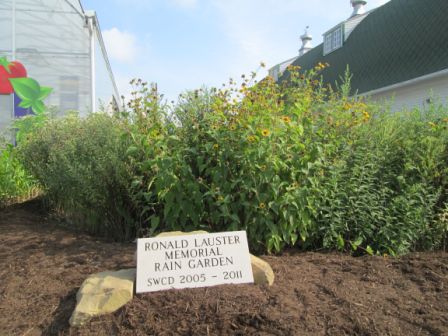Water Management
We have seen some fairly severe weather in the past few years in central Indiana. We have had both extreme flooding and prolonged weeks and months of drought. While we cannot control the weather, we can make small changes on our properties that, when added to those small steps taken by our neighbors, can make significant improvements for water management.
The Natural Resources Conservation Service has produced a booklet that provides a nice overview of several options for how homeowners can include practices to decrease the amount of runoff leaving their properties. These small steps help improve water quality, conservation, and decrease flooding problems downstream. Download Slow It – Spread It – Sink It
Read more below to take steps for water management.
Rain Gardens
Rain Gardens are becoming a popular conservation practice in urban areas because they are a small step that landowners can make to help decrease runoff and flooding in their community. Rain gardens are created to be depressional garden areas where surface runoff can collect and percolate down through the soil. Percolation is improved through soil amendments and the use of deep rooted native plants.
The Marion County SWCD has developed a new rain garden guide which you can download HERE.
(Our Rain Garden Guide was sponsored by Heartland Backyard Conservation Program and Clean Water Indiana)
Purdue Extension Service has produced a couple of DIY instructional YouTube videos on how to design and build your own rain garden.
Part 1: Sizing and designing a rain garden
Part 2: Installation
Information found in the Marion County Soil Survey can be very valuable in determining if your soil type is suitable for a rain garden.
More information on rain gardens:

Rain Barrels
What is a rain barrel?
A rain barrel is a system that collects and stores rainwater from your roof that would otherwise run off and be diverted to storm drains, streams, and the White River. It is composed of a large drum (usually about 50 – 60 gallons) a vinyl hose, PVC couplings, a screen grate to keep debris and insects out, and other common items. A rain barrel is relatively simple and inexpensive to construct and can sit conveniently under a residential gutter downspout.
Rain barrels have become very popular again because they lower water bills for those who water their gardens in the summer, rain water is better for plants than chlorinated city water, and collecting water during storms helps to decrease runoff from our properties thus making a small step towards controlling flooding downstream.
Some local sources include:
- Express Yourself Rainbarrels (a social enterprise of the KHEPRW Instituite)
- Hamilton County SWCD
- Or build your own using our rain barrel fact sheet
Bioswales
Below is a video on green techniques for water management and their effect on improving water quality.


